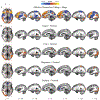Psychopathy is associated with fear-specific reductions in neural activity during affective perspective-taking
- PMID: 32898678
- PMCID: PMC9831240
- DOI: 10.1016/j.neuroimage.2020.117342
Psychopathy is associated with fear-specific reductions in neural activity during affective perspective-taking
Abstract
Psychopathic individuals are notorious for their callous disregard for others' emotions. Prior research has linked psychopathy to deficits in affective mechanisms underlying empathy (e.g., affective sharing), yet research relating psychopathy to cognitive mechanisms underlying empathy (e.g., affective perspective-taking and Theory of Mind) requires further clarification. To elucidate the neurobiology of cognitive mechanisms of empathy in psychopathy, we administered an fMRI task and tested for global as well as emotion-specific deficits in affective perspective-taking. Adult male incarcerated offenders (N = 94) viewed images of two people interacting, with one individual's face obscured by a shape. Participants were cued to either identify the emotion of the obscured individual or identify the shape from one of two emotion or shape choices presented on each trial. Target emotions included anger, fear, happiness, sadness, and neutral. Contrary to predictions, psychopathy was unrelated to neural activity in the Affective Perspective-taking > Shape contrast. In line with predictions, psychopathy was negatively related to task accuracy during affective perspective-taking for fear, happiness, and sadness. Psychopathy was related to reduced hemodynamic activity exclusively during fear perspective-taking in several areas: left anterior insula extending into posterior orbitofrontal cortex, right precuneus, left superior parietal lobule, and left superior occipital cortex. Although much prior research has emphasized psychopathy-related abnormalities in affective mechanisms mediating empathy, current results add to growing evidence of psychopathy-related abnormalities in a cognitive mechanism related to empathy. These findings highlight brain regions that are hypoactive in psychopathy when explicitly processing another's fear.
Keywords: Emotion; Empathy; Fmri; Psychopathology; Psychopathy; Social cognition.
Copyright © 2020. Published by Elsevier Inc.
Conflict of interest statement
Financial disclosures
The authors declare no competing financial interests.
Figures




Similar articles
-
Neural processing of dynamic emotional facial expressions in psychopaths.Soc Neurosci. 2014 Feb;9(1):36-49. doi: 10.1080/17470919.2013.866905. Soc Neurosci. 2014. PMID: 24359488 Free PMC article.
-
Impaired cognitive empathy in criminal psychopathy: evidence from a laboratory measure of empathic accuracy.J Abnorm Psychol. 2013 Feb;122(1):156-166. doi: 10.1037/a0030261. Epub 2012 Oct 15. J Abnorm Psychol. 2013. PMID: 23067260
-
Psychopathic traits linked to alterations in neural activity during personality judgments of self and others.Neuroimage Clin. 2018 Feb 28;18:575-581. doi: 10.1016/j.nicl.2018.02.029. eCollection 2018. Neuroimage Clin. 2018. PMID: 29845005 Free PMC article.
-
Mirror neurons and empathy-related regions in psychopathy: Systematic review, meta-analysis, and a working model.Soc Neurosci. 2022 Oct;17(5):462-479. doi: 10.1080/17470919.2022.2128868. Epub 2022 Oct 4. Soc Neurosci. 2022. PMID: 36151909
-
Not just fear and sadness: meta-analytic evidence of pervasive emotion recognition deficits for facial and vocal expressions in psychopathy.Neurosci Biobehav Rev. 2012 Nov;36(10):2288-304. doi: 10.1016/j.neubiorev.2012.08.006. Epub 2012 Aug 27. Neurosci Biobehav Rev. 2012. PMID: 22944264 Review.
Cited by
-
Impaired salience network switching in psychopathy.Behav Brain Res. 2023 Aug 24;452:114570. doi: 10.1016/j.bbr.2023.114570. Epub 2023 Jul 7. Behav Brain Res. 2023. PMID: 37421987 Free PMC article.
-
Neural responses to morally laden interactions in female inmates with psychopathy.Neuroimage Clin. 2021;30:102645. doi: 10.1016/j.nicl.2021.102645. Epub 2021 Mar 27. Neuroimage Clin. 2021. PMID: 33838544 Free PMC article.
-
Using physiological biomarkers in forensic psychiatry: a scoping review.Front Psychiatry. 2025 Apr 29;16:1580615. doi: 10.3389/fpsyt.2025.1580615. eCollection 2025. Front Psychiatry. 2025. PMID: 40365003 Free PMC article.
-
Cognitive Empathy in Subtypes of Antisocial Individuals.Front Psychiatry. 2021 Jul 5;12:677975. doi: 10.3389/fpsyt.2021.677975. eCollection 2021. Front Psychiatry. 2021. PMID: 34290630 Free PMC article. Review.
-
Psychopathy, pain, and pain empathy: A psychophysiological study.PLoS One. 2024 Jul 5;19(7):e0306461. doi: 10.1371/journal.pone.0306461. eCollection 2024. PLoS One. 2024. PMID: 38968264 Free PMC article.
References
-
- Aniskiewicz AS, 1979. Autonomic components of vicarious conditioning and psychopathy. J Clin Psychol. - PubMed
-
- Blair RJR, 2005a. Applying a cognitive neuroscience perspective to the disorder of psychopathy. Dev. Psychopathol 17, 865–891. - PubMed
-
- Blair RJR, 2005b. Responding to the emotions of others: dissociating forms of empathy through the study of typical and psychiatric populations. Conscious Cogn 14, 698–718. - PubMed
Publication types
MeSH terms
Grants and funding
LinkOut - more resources
Full Text Sources

